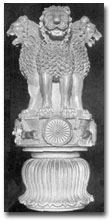
At Sarnath Near Varanasi (Benares) in North India, about two centuries after Gautama Buddha gave his first sermon and turned the Wheel of Dharma, the Emperor Ashoka erected a pillar. The four lions at its crown representing the "lion's roar of the dharma" (shakyasimha) in the cardinal directions, were adopted by modern India as the national coat of arms. At the lions' base is the Wheel of Dharma (the Ashoka Chakra) reproduced at the center of the Indian flag and the images of horse, a bull, an elephant and a lion. The base is in the (stylized) shape of an inverted lotus.
All across his empire Ashoka erected pillars of polished sandstone, on bases called "Stupas". The pillars are popularly known as the Ashoka Pillars and all of them carried edicts of "Dhamma" (Prakrit term for the Sanskrit "Dharma"). They carried messages from the Emperor, on matters of human conduct and correct government. Most of the pillars have disappeared through the ravages of time but a few are still standing. Unlike the Pillar at Sarnath, other pillars carried only an animal at the crown; while most had a lion, others had a bull or an elephant.